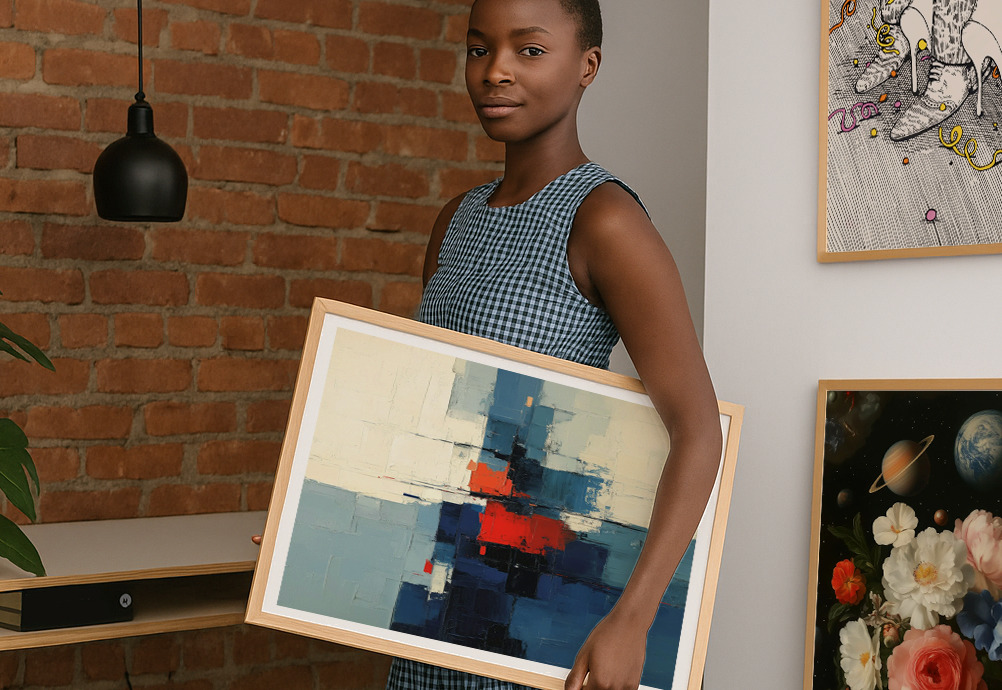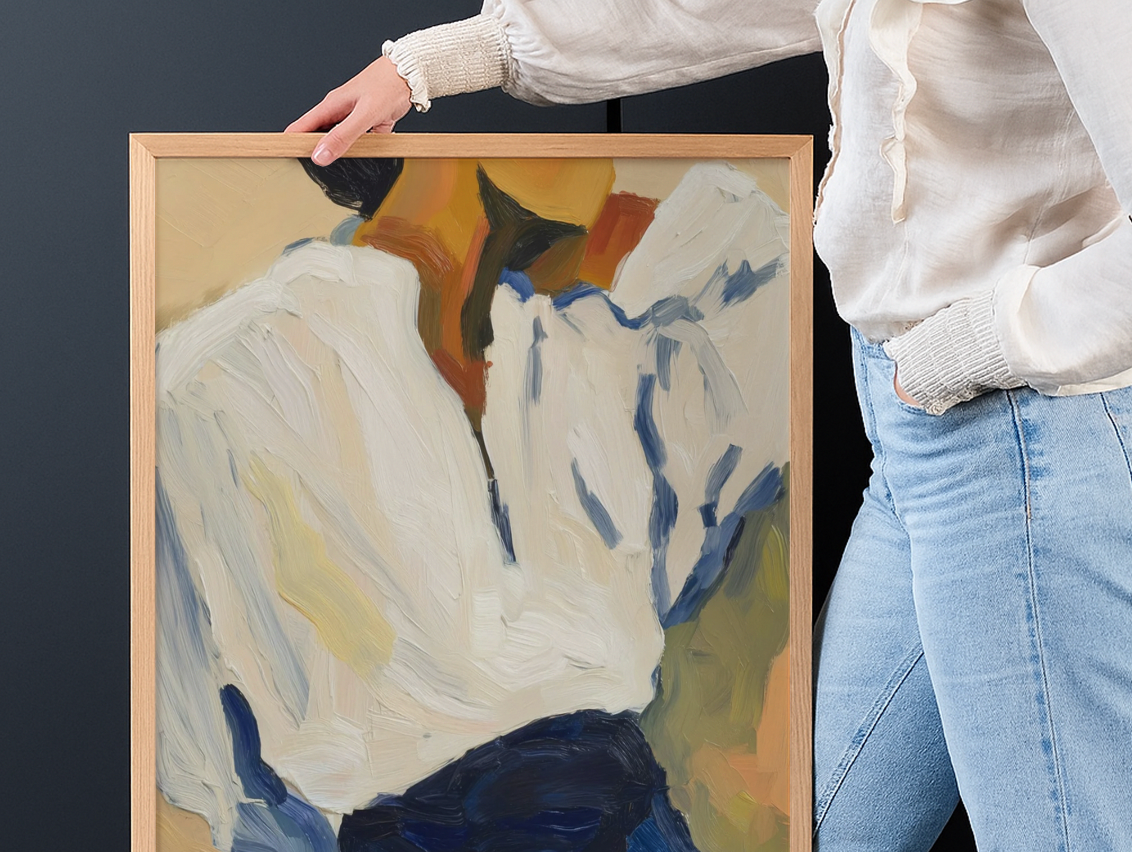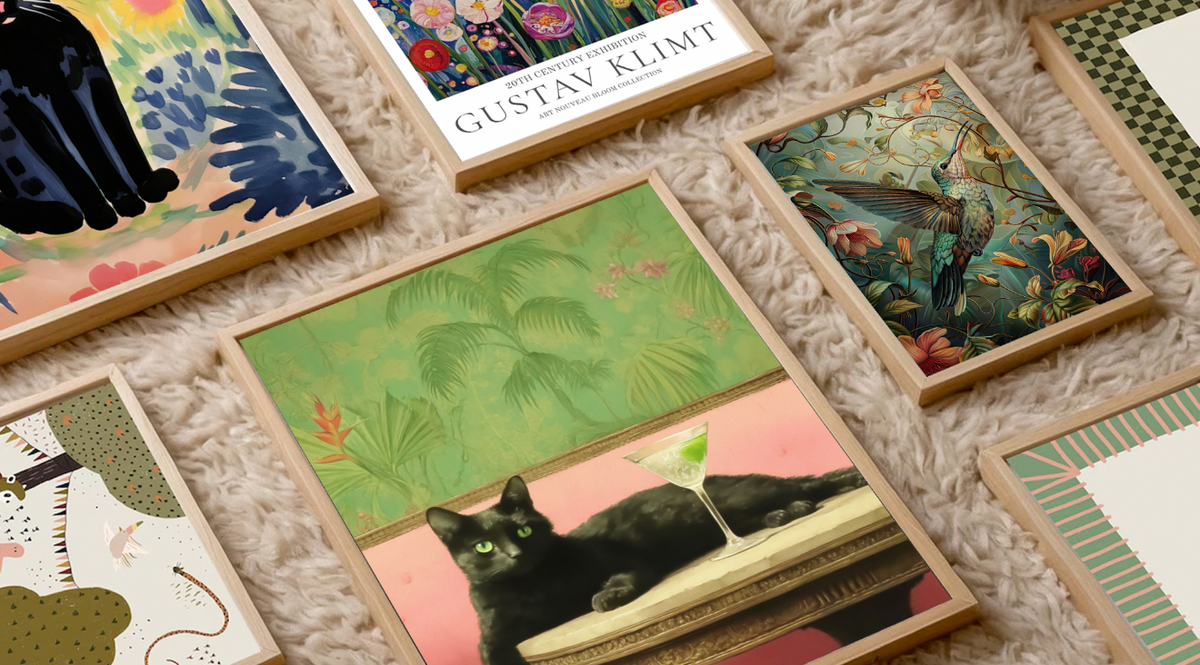How To Mix Abstract and Figurative Wall Art
How to combine abstract and figurative art in a way that feels balanced, expressive, and totally intentional.

You love that bold abstract with the swirling blues and oranges. But you also can't stop thinking about the botanical print with the delicate leaves. So you buy both, hang them up, and suddenly wonder if your wall looks like a confused art student's dorm room.
Here's the thing. Mixing abstract and figurative art isn't just allowed, it's often what makes a room feel truly interesting. The key is understanding what each style brings to your space and how to make them work together instead of against each other.
What Each Style Does for Your Room
Abstract art brings energy and emotion. It's the piece that makes you feel something you can't quite name. Maybe it's calming, maybe it's energizing, but it hits you on a gut level before your brain has time to analyze it.
Figurative art tells stories. It gives your eye something concrete to focus on. A landscape, a portrait, a still life. Your brain recognizes what it's seeing and can relax into the narrative.
When you combine them, you get both the emotional punch of abstract work and the visual anchor of figurative pieces. Your room feels dynamic but not chaotic. Expressive but not overwhelming.
Why Playing It Safe Gets Boring
A lot of people stick to one style because it feels safer. All landscapes, or all abstracts, or all black and white photography. And sure, it's cohesive. But it can also feel flat.
Mixing styles creates visual tension in the best possible way. Your eye moves from the story of a figurative piece to the pure feeling of an abstract one. The contrast makes both styles more interesting than they would be on their own.
Plus, mixing styles says something about you. It shows that your taste is complex, that you respond to different kinds of beauty. Your walls become more personal, less predictable.
Color as the Bridge
The easiest way to make different styles work together is through color. Maybe your abstract has deep blues and your botanical print has blue-green leaves. Or your landscape has warm earth tones that connect to the oranges in your abstract piece.
You don't need exact matches. In fact, exact matches can look forced. But having colors that relate to each other creates harmony even when the styles are completely different.
Sometimes the connection is more subtle. Both pieces might have the same intensity of color, or the same temperature. A soft, muted abstract can work beautifully next to a gentle figurative piece, even if the actual colors are different.
Playing with Scale and Shape
Visual rhythm matters when you're mixing styles. If everything is the same size and shape, it gets monotonous. But if everything is different, it gets chaotic.
Try balancing a large abstract with a smaller figurative piece. Or pair a horizontal landscape with a vertical abstract. The different scales and orientations create movement while the repeated elements (maybe similar frames or colors) keep things cohesive.
What size print you need for your wall becomes more complex when you're mixing styles, but the basic principles still apply. You want pieces that feel proportional to each other and to your space.
Letting One Style Lead
Sometimes it helps to let one style be the star and use the other as support. Maybe you have one large abstract that dominates the wall, with smaller figurative pieces around it. Or a series of figurative prints with one abstract piece that adds energy to the group.
This approach feels more intentional than trying to give equal weight to both styles. It shows you made a choice about what matters most in that space.
But you don't have to follow this rule. Some of the most interesting walls give equal weight to different styles. It depends on your space and what feels right to you.
Building Gallery Walls That Work
Gallery walls are perfect for mixing styles because you can play with the relationships between pieces. Start with your strongest piece, whether it's abstract or figurative, and build around it.
Use the strong piece as your anchor and arrange the others to support it. Maybe your abstract piece needs the visual weight of a bold figurative print to balance it. Or your landscape needs the energy of a smaller abstract to keep it from feeling too quiet.
How you arrange art above furniture affects how the mixed styles read together. Pieces that are closer together need to relate more strongly. Pieces with more space between them can be more different from each other.
Getting the Framing Right
Frame choices can make or break a mixed-style arrangement. The frames don't have to match exactly, but they should feel like they belong together.
Simple, similar frames usually work best when you're mixing styles. The art gets to be the star, and the frames just provide a consistent structure. Ornate or wildly different frames can compete with the art and make everything feel chaotic.
Framed vs unframed becomes an interesting choice when mixing styles. Sometimes an unframed abstract piece next to a framed figurative one creates just the right amount of contrast. But be careful not to let the framing choices overwhelm the art choices.
Avoiding the Chaos Trap
The biggest mistake people make when mixing styles is not having enough connection between pieces. You need something that ties them together, whether it's color, scale, subject matter, or mood.
Another common problem is overthinking it. You find pieces you love individually, but then you analyze them to death trying to figure out if they work together. Sometimes they just do, even if you can't explain why.
Trust your eye. If two pieces make you happy when you see them together, they probably work together. Your intuition about what looks good is usually better than any rule.
When Contrast Creates Harmony
Some of the best combinations come from pieces that seem like they shouldn't work together but somehow do. A detailed botanical print next to a loose, gestural abstract. A precise geometric piece next to a soft, organic figurative work.
The contrast highlights what's special about each piece. The detailed botanical looks even more intricate next to the simple abstract. The geometric piece feels more structured next to the organic one.
This kind of pairing takes confidence, but it often creates the most interesting and personal spaces.
Starting Small and Building
If you're not sure about mixing styles, start small. Try pairing just two pieces in a low-stakes spot like a hallway or bedroom. See how they feel together. Live with them for a while.
You'll start to notice what works and what doesn't. Maybe you discover you like high contrast, or maybe you prefer subtle connections. Maybe you like equal balance, or maybe you prefer one style to dominate.
There's no right answer, just what works for your eye and your space.
Making It Feel Intentional
The difference between a thoughtfully mixed wall and a random collection is intention. Even if you can't articulate why certain pieces work together, there should be some underlying logic.
Maybe it's the mood they create together. Maybe it's the way they balance each other visually. Maybe it's just that they all make you feel something good when you see them.
Choosing the right art for your home becomes more interesting when you're not limiting yourself to one style. You get to respond to different kinds of beauty and create spaces that reflect more of who you are.
Trust Your Taste
Here's what I've learned from helping people mix art styles. Your taste is more coherent than you think it is. The abstract pieces you're drawn to and the figurative pieces you love probably have more in common than you realize.
Maybe they share a mood, or a color palette, or an energy level. Maybe they just all feel like you. Trust that connection, even if you can't name it.
The best mixed-style walls don't follow rules. They follow the taste and instincts of the person who lives with them every day. And that person is you.
Ready to create your own mix? Explore the Fab collection and build your own combination — bold, beautiful, and totally you.
Fab products featured in this blog
-
Lámina colores de Colliure de André Derain
Translation missing: es.products.product.sale_priceDesde £12.95£17.95 -
Lámina geometría azul y violeta de Schillinger
Translation missing: es.products.product.sale_priceDesde £12.95£17.95 -
Lienzo abstracto de bruma en tonos rojos suaves
Translation missing: es.products.product.sale_priceDesde £50.39£71.99 -
Lámina bloques de color de Richard Baringer
Translation missing: es.products.product.sale_priceDesde £12.95£17.95 -
Lámina desnudo azul de Henri Matisse
Translation missing: es.products.product.sale_priceDesde £12.95£17.95 -
Lámina rayas rosa empolvado y blanco
Translation missing: es.products.product.sale_priceDesde £12.95£17.95 -
Lámina ensueño de cítricos
Translation missing: es.products.product.sale_priceDesde £12.95£17.95 -
Lámina momentos del metro de la ciudad
Translation missing: es.products.product.sale_priceDesde £12.95£17.95 -
Lámina gato musa en bloques de color
Translation missing: es.products.product.sale_priceDesde £12.95£17.95 -
Lámina calma íntima con gato
Translation missing: es.products.product.sale_priceDesde £12.95£17.95 -
Lámina escena acuática de los canales de Ámsterdam
Translation missing: es.products.product.sale_priceDesde £12.95£17.95 -
Lámina retrato con bloques de color vibrantes
Translation missing: es.products.product.sale_priceDesde £12.95£17.95 -
Lámina de gato en arte pop estilo Mondrian
Translation missing: es.products.product.sale_priceDesde £12.95£17.95 -
Lámina pinceladas retro de Magleby
Translation missing: es.products.product.sale_priceDesde £12.95£17.95
More from The Frame
More stories, insights, and behind-the-scenes looks at the art that transforms your space.
Top Wall Art Trends for 2025: What's In, What's...
Trends aren't rules to follow blindly. They're signals about where our collective taste is heading, what's capturing our imagination, and what feels fresh right now. The wall art trending in...
Art for Gifting: How to Choose a Print for Some...
Giving someone art is either incredibly thoughtful or slightly terrifying. There's no middle ground. On one hand, you're giving them something beautiful that will live in their home for years....
9 Art Prints That Instantly Elevate Any Living ...
You know that feeling when you walk into a beautifully styled living room and everything just feels right? It's not the expensive sofa or the perfect rug. It's usually the...

























